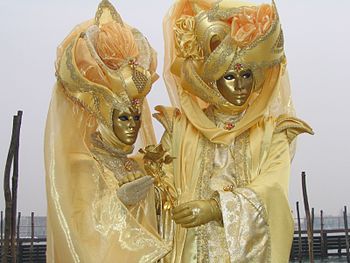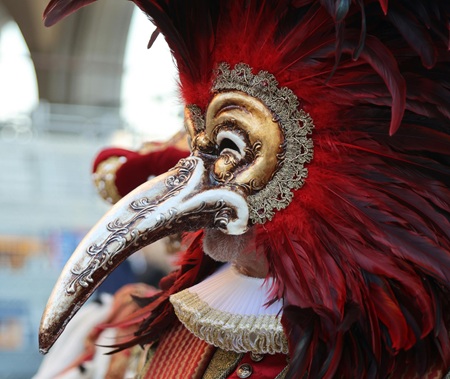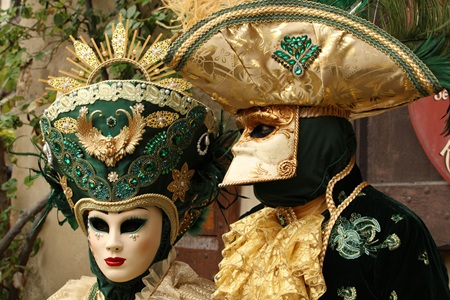La maschera è il modo più antico che l’essere umano conosca per abbandonare la propria identità ed assumerne un’altra totalmente diversa. Mascherarsi da animali permetteva ai cacciatori primordiali di mimetizzarsi e sorprendere la preda, ma anche di assumere ritualmente, con l’aspetto, poteri e qualità che venivano attribuitiva certi animali.
Ti piace mascherarti? |
The mask is the oldest way known to human beings to abandon their identity and assume a totally different one. Disguising oneself as animals allowed the primordial hunters to mimic and surprise their prey, and also to ritually assume, through appearance, the powers and qualities owned by certain animals.
Do you like to be in disguise? |
|---|
Carnevale a Venezia
Share this activity:
| Era inevitabile che l’uomo pensasse alla maschera come al modo per assumere l’identità di altri esseri umani e addirittura esseri sovrumani o mitici, e scoprisse le enormi possibilità narrative, mistiche e mistificatorie della maschera. Sciamani e preti, cantastorie ed attori, briganti e libertini sono solo alcuni dei tanti cultori del travestimento di cui il Carnevale celebra la memoria. | Inevitably, man thought of the mask as a way to assume the identity of other beings, even superhuman or mythical beings, and discovered the enormous narrative, mystical and deceitful possibilities of the mask. Shamans and priests, ballad singers and actors, bandits and libertines are only some of the many characters of which the Carnival celebrates the memory. |
|---|---|
| Arlecchino e Pulcinella, due delle maschere più popolari della tradizione italiana sembrano sintetizzare molti degli elementi menzionati. Si veda di entrambi la maschera nera dalla smorfia sardonica che tradisce l’origine demoniaca. Già Dante Alighieri nel canto 21 dell’Inferno attribuisce ad uno dei diavoli il nome di Alichino, che l’etimologia antico tedesca del nome ci indica come "Re degli Inferi", così come il nome di Pulcinella si riferisce alla voce fioca e sottile da "pulcino", ma anche da "morto che parla", della maschera incappucciata. | Arlecchino and Pulcinella, two of the most popular masks of the Italian tradition, seem to summarize many of the above mentioned elements. Both use a black mask with a sardonic grimace that betrays their demoniac origin. Dante Alighieri, (Canto 21 of the Inferno), attributes to one of the devils the name of Alicchino, which the ancient German etymology of the name indicates as "King of Hell", and the name Pulcinella refers to the dim and subtle voice of "chick", but also to the "death who speaks", typical voice of the hooded mask. |
| In queste maschere demoniache, che si sostuirono ai personaggi mitologici della classicità Greca e Romana ancora popolari ai tempi "carnascialeschi" di Lorenzo il Magnifico e dei suoi lussuosi carri allegorici o "Trionfi", possiamo riconoscere, non solo nel nome, l’influenza lugubre della tradizione celtica e nord europea che è ancora viva nell’americanissima nottata di "Halloween"; quando gli spiriti dei morti, rappresentati da personaggi mascherati in modo spaventoso, visitano i vivi estorcendo offerte con minacce di rappresaglie. | These demoniac masks substitute the mythological characters of the Greek and Roman classics still popular in the "carnascialeschi" times of Lorenzo il Magnifico and his luxurious allegorical carts or "Triumphs". In these masks we are able to recognize, not only in the name, the gloomy influence of the Celtic and north European tradition, which is still alive in the very American "Halloween night", where the spirits of the dead, represented by frightfully masked characters, visit the living and extort offers with threats of retaliation. |
| Che personaggi diabolici e dell’oltretomba si siano trasformati, anche grazie alla Commedia dell’Arte, in personaggi comici e satirici la dice lunga sull’Italia e gli Italiani. Molto prima che Carlo Goldoni e il suo settecentesco "Arlecchino servitore di due padroni" consacrasse in tutti i teatri del mondo Arlecchino come un furbo popolano dalle risorse inesauribili, era divenuto ormai abituale che sui palcoscenici allestiti nelle piazze italiane durante fiere e feste popolari dalle compagnie viaggianti di attori e saltimbanchi comparissero personaggi mascherati dall’aspetto grottesco o ridicolo non più con lo scopo di spaventare ma con quello, opposto e più divertente, di satireggiare vizi e difetti umani. Il medico incompetente ed avido, il mendicante scaltro e ladro, il gentiluomo ricco e borioso, la donzella civetta e approfittatrice, l’avvocato rapace e senza scrupoli, il servo infedele, il contadino rozzo e furbastro sono solo alcuni dei tipi, abbigliati in modo da renderne immediatamente riconoscibile classe sociale o professione, che si andarono affermando nelle caricature teatrali improvvisate. | The fact that these diabolical and frightful characters have been transformed, thanks also to the Commedia dell'Arte (Comedy of the Art), in comical and satirical characters, explains many things about Italy and the Italians. Long before Carlo Goldoni (with his 1700's "Arlecchino, server of the Two Masters") consecrated Arlecchino, in all the theatres of the world, as a crafty common man with inexhaustible resources, it was common to productions staged by travelling companies of actors and acrobats, during fairs and festivals in the Italian squares, to present masked characters with a grotesque or ridiculous appearance, not more with the purpose of frightening the audience, but with that, opposite and more fun, of satirizing human vices and defects. The incompetent and avid doctor, the shrewd and thievish mendicant, the rich and haughty gentleman, the coquettish and selfish maiden, the rapacious and unscrupulous lawyer, the unfaithful servant, the rough and cunning farmer are only some of the types, dressed up in ways that immediately render recognizable social or professional classes, represented in those improvised theatrical performances. |
Arlecchino e Pulcinella furono affiancati da Colombina, Pantalone, Meneghino, Zani, Brighella, Gianduia, Stentarello e tanti altri eroi negativi dalle potenzialità comiche illimitate.
Se si tiene presente il vivissimo campanilismo italico, che alimentava fino al cinquecento cruente guerre di tutti contro tutti e che ha rimandato l’unificazione del paese a poco più di cento anni fa, non è difficile immaginare come diventasse comune attribuire a ciascuna maschera, con intenti derisori, particolarmente utili a captare la benevolenza del pubblico locale, atteggiamenti e cadenze dialettali di città e paesi rivali o lontani da quelli dove ci si trovava a recitare. La rivalità con le altre città aveva presso il pubblico la meglio su ogni altra rivalità sociale interna. |
Arlecchino and Pulcinella created a team with Colombina, Pantalone, Meneghino, Zani, Brighella, Gianduia, Stentarello and many other unfavorable heroes with a boundless, comic potentiality.
If you keep in mind the liveliest Italic localism, which fed bloody wars among all towns until the end of the 1500s, and which delayed the unification of the country until less than a century ago, it is not difficult to imagine how it became common to attribute to every mask, (with derisive intentions particularly useful to gain the benevolence of the local public), attitudes, accents and dialects of the rivaling towns or of cities far away from the theatre or square where the performance was staged. The rivalry with other cities had more success with the public than any other internal or social rivalry. |
Carnevale a Venezia

| I personaggi, partoriti in questo modo dalla creatività dei teatranti e che riscuotevano più successo, diventarono rapidamente tipici e codificati. Sui palcoscenici di tutta Italia, particolarmente attivi in tempo di Carnevale, cominciarono ad interagire "maschere" che tutti immediatamente riconoscevano come rappresentanti le caratteristiche o meglio i difetti e vizi peggiori, dei diversi paesi e città d’Italia; forse con il segreto risentimento di qualcuno ma certamente con divertimento sommo di tutti. | The more successful characters, brought forth in this way by the creativity of the actors, soon became typical and codified. On all Italian stages, particularly active in the times of the Carnivals, the performing "masks" were recognized immediately as representatives of the characteristics, or better yet, the defects and worst vices of the diverse towns and cities of Italy; there was maybe the secret resentment of someone, but the supreme entertainment was assured for all. |
|---|---|
| Non si trattava certo di tempi troppo "politically correct" e dato che opporsi alla satira non faceva probabilmente che renderla più acuta ed evidente, ciascuna città finì per adottare il personaggio che la rappresentava e spesso con orgoglio lo faceva marciare in testa alle processioni municipali con il vescovo ed il podestà locale all’ombra del gonfalone comunale. Fu così che prima ancora che la contemporanea società dello spettacolo producesse le maschere di "Zorro", "Lawrence d’Arabia", "Batman" e altre icone del nostro tempo, furono i personaggi della Commedia dell’Arte ad animare i cortei di Carnevale. | It certainly wasn't a time of "political correctness", and, given that the opposition to the satire would have probably made it more intense and evident, every city adopted the character that represented it. This mask would often march proudly at the head of the municipal processions with the bishop and the local podestà in the shade of the city banner. Long before the contemporary showbusiness society produced the masks of "Zorro", "Lawrence of Arabia", "Batman", and other icons of our time, the characters of the Commedia dell'Arte animated the processions of the Carnival. |
| Naturalmente allora, più di quanto accada nella società permissiva di oggi, qualsiasi maschera e costume si scegliesse per Carnevale, lo scopo era soprattutto quello di non farsi riconoscere mentre con la scusa del Carnevale si sfidavano le probizioni più severe. Casanova nelle sue celebri memorie è particolarmente esplicito circa i vantaggi di un efficace travestimento in una città come Venezia dove l’allegria del Carnevale è sempre stata molto sentita forse perché infrangere le regole, spassarsela e farla franca in tempi "normali’ è sempre stato più difficile che altrove. Non sempre maschere e costumi avevano lo scopo di permettere azioni che potevano essere censurate al termine della festa. In occasione dei gran balli di Carnevale che i patrizi delle città italiane organizzavano ed organizzano ancora oggi, con gran fasto, spesso lo scopo era proprio l’opposto. Fingendo di nascondersi si voleva paradossalmente ostentare la propria ricchezza, creatività e fantasia attirando l’attenzione di tutti proprio grazie alle quasi illimitate possibilità esibizionistiche che un costume di carnevale può offrire. | Naturally, at that time, more than it happens in today permissive society, any mask and costume was chosen, above all purposes, to disguise oneself while challenging, under the pretext of the Carnival, the most severe prohibitions. In his famous memories, Casanova is particularly explicit about the advantages of an effective disguise in a city like Venice, where the cheerfulness of Carnival had always been much needed and "having fun", and not being punished for that, had always been more difficult than anywhere else. Masks and costumes not always had the purpose of permiting actions that could be censored at the end of the festival. In occasions of the great Carnival balls that the nobles of the Italian cities organized, and still organize today, with great splendor, often the purpose was just the opposite. Pretending to hide oneself, one wanted paradoxically to show off their own riches, creativity and fantasy, drawing the attention of all on exhibiting oneself, thanks to the almost unlimited possibilities that a Carneval costume is able to offer. |
E come ci si può facilmente rendere conto a Venezia, come in molte località italiane da Abano Terme a Zoagli, durante le settimane di Carnevale, ma anche in tempo di quaresima o durante il resto dell’anno, gli Italiani pur di fare "una bella figura" sono disposti a tutto e per fortuna non sembrano aver mai dimenticato quanto scrisse Lorenzo il Magnifico nel "Trionfo di Bacco ed Arianna":
Viva Bacco e
viva Amore! |
As it can be easy to realize in Venice, as in many other Italian localities from Abano Terme to Zoagli, during the weeks of Carnival, but also in the time of Lent or during the rest of the year, the Italians would do anything to make a good impression, and luckily, they never seem to have forgotten what Lorenzo il Magnifico wrote in the "Triumph of Bacchus and Ariadne":
Live Bacchus
and Live Ariadne! |
| Carnevale (parte 1) | Carnival (part 1) |

